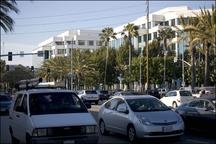
EASTSIDE — A slew of commercial and residential developments proposed for the eastside of Santa Monica is causing alarm among neighborhood groups who fear the projects aren’t getting a careful enough analysis from City Hall and have the potential to turn a bad traffic problem in the area into a disaster.
The projects are all in the early planning stages and are yet to receive approval from the City Council.
But the proposals have neighborhood activists like Diana Gordon, co-founder of the Santa Monica Coalition for a Livable City, concerned developers are trying to circumvent City Hall’s plans for the area by ramming through development agreements before City Hall’s general plan update is completed later this year.
The update, known as the Land Use and Circulation Element (LUCE), is expected to be approved by this summer and is part of City Hall’s 25-year development plan. It will put in place strict limits on building height, density and parking allotment, in addition to other rules.
Six projects are planned for the eastside area known as the Light Manufacturing and Studio District, a zone that spans 26th Street to Centinela Avenue, and from the I-10 Freeway to Colorado Avenue.
Together the projects total nearly 2-million-square-feet of new space, according to a list compiled by Zina Josephs of the Friends of Sunset Park neighborhood group. The two largest are a mixed-use building proposed for the vacant Papermate manufacturing site that would total nearly 1-million square feet, and the Paseo Nebraska project, which envisions 356,000 square feet and came before the Planning Commission Wednesday night.
Many of the proposals are seeking development agreements with City Hall that would allow them to exceed height restrictions being considered for the area.
“Every single one of these developers is coming in wanting the moon,” Gordon said, with proposals that go “beyond what the draft LUCE contemplates.”
Though most of the projects won’t come before the council for final approval until after the LUCE is adopted, Gordon said the fear is that the projects will gain momentum by getting initial conceptual approval beforehand and will be difficult to reign in down the line.
She and other members of her group have proposed that the council slow down the pace of planning by delaying the so-called “float-up” process for the projects until after the LUCE gets final approval. In the float-up process, developers ask the Planning Commission and City Council to approve their initial project concepts before submitting detailed plans and environmental studies for approval. Typically the float-up process, which is ongoing for five of the six projects, happens about a year before projects come before the council for a final vote.
Gordon is also asking City Council to require an analysis of the projects’ cumulative impacts before giving any of them initial approval. She said the total traffic impacts of the projects are still unknown.
“The problem is it’s going to yield a tidal wave of un-needed commercial development in one small area of the city that can’t possibly accommodate it all,” she said of the proposals.
Gordon has an ally on the Planning Commission in Jay Johnson, who recently proposed implementing a moratorium on development agreements until the LUCE is adopted. But so far he’s in the minority. His moratorium suggestion, he said, got no support on the Planning Commission, in part because of concerns it would violate land owners’ property rights.
Others on the commission and at City Hall see fears about pre-LUCE development agreements as overblown.
Hank Koning, who chairs the Planning Commission, said having a large number of projects come before the commission before the LUCE is adopted is a benefit.
By considering projects before hard-and-fast rules about structure height, density and parking allotments are in place, city officials will be better able to make informed decisions about what the rules should be, he said.
“In a way we’re lucky that we have all these projects coming up now that will ultimately come back later on to get approved ... after the LUCE is approved,” he said. “It’s great. It’s giving us some test cases.”
Though Koning said he agrees the projects’ impacts need to be looked at collectively, he argued the review process for any development already takes surrounding projects into account.
City Hall hires independent consultants to conduct environmental reviews for proposed developments, he said, and every review looks at existing traffic as a constraint.
City Hall’s planning director, Eileen Fogarty, also said there’s no risk the proposed projects will be allowed to get around the restrictions that will ultimately be approved in the LUCE.
“The actual project proposal for any of [the eastside developments] is more than a year away,” she said, noting the exception of the Lionsgate project at 2834 Colorado Ave., which has completed its draft EIR.
She said some of the proposals for the eastside envision developments that are at odds with the LUCE and will likely be rejected or substantially altered by the council.
“Clearly, you have some of these projects that are not consistent with anything,” she said.








